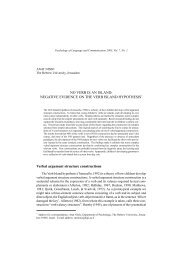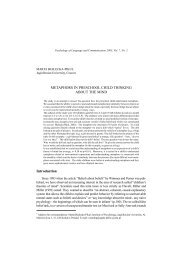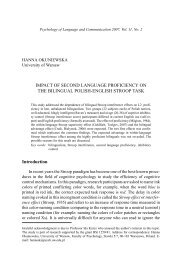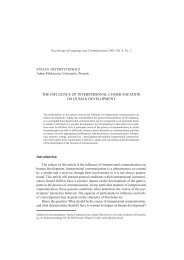The effecTs of groUP coNscioUsNess oN JAPANese lANgUAge ...
The effecTs of groUP coNscioUsNess oN JAPANese lANgUAge ...
The effecTs of groUP coNscioUsNess oN JAPANese lANgUAge ...
You also want an ePaper? Increase the reach of your titles
YUMPU automatically turns print PDFs into web optimized ePapers that Google loves.
92 Norie Mogi<br />
Mizutani, O. (1979). Hanashikotoba to nihonjin: Nihongo no seitai (Spoken Japanese and<br />
the Japanese people: A model <strong>of</strong> the Japanese language). Tokyo: Sootakusha.<br />
Mizutani, O. & Mizutani, N. (1977). Nihongo notes (Notes on the Japanese language).<br />
Tokyo: <strong>The</strong> Japan Times.<br />
Morita, Y. (1995). Nihongo no shiten (Perspectives in the Japanese language). Tokyo:<br />
Sootakusha.<br />
Morita, Y. (1998). Nihonjin no hassoo, nihongo no hyoogen (Ways <strong>of</strong> expressing <strong>of</strong> the<br />
Japanese and the Japanese language expression). Tokyo: Chuuookooronsha.<br />
Nakane, C. (1970). Japanese society. Los Angeles: University <strong>of</strong> California Press.<br />
Nakane, C. (1976). Tateshakai no ningenkankei (Human relations in a vertical society).<br />
Tokyo: Koodansha.<br />
Nakane, C. (1978). Tateshakai no rikigaku (Dynamics in a vertical society). Tokyo:<br />
Koodansha.<br />
Shibata, T. (1976). Sekai no nana no nihongo (<strong>The</strong> Japanese language <strong>of</strong> the world). In S.<br />
Oono & T. Shibata (Eds.), Iwanami kooza nihongo 1: Nihongo to kokugogaku (<strong>The</strong><br />
Iwanami course <strong>of</strong> the Japanese langauge 1: the Japanese langauge and the Japanese<br />
philogogy). (pp.1-29). Tokyo: Iwanami Shoten.<br />
Shibata, T. (1977). Nihonjin no gengoseikatsu (Japanese people’s linguistic life). In S.<br />
Oono & T. Shibata (Eds.), Iwanami kooza Nihongo 2: Gengo seikatsu (<strong>The</strong> Iwanami<br />
course <strong>of</strong> the Japanese langauge 2: Langauge life). (pp.33-81). Tokyo: Iwanami Shoten.<br />
Shibata, T. (1978). Shakaigengogaku no kadai (Problems <strong>of</strong> sociolinguistics). Tokyo:<br />
Sanseido Shoten.<br />
Shibata, T. (1995). Nihongo wa omoshiroi (<strong>The</strong> Japanese language is interesting). Tokyo:<br />
Iwanami Shoten.<br />
Sugiyama L. T. (1976). Japanese patterns <strong>of</strong> behavior. Hawaii: University <strong>of</strong> Hawaii Press.<br />
Suzuki, T. (1973). Kotoba to bunka (Language and culture). Tokyo: Iwanami Shoten.<br />
Suzuki, T. (1975). Tozasaretagengo: nihongo no sekai (<strong>The</strong> closed language: the world <strong>of</strong><br />
the Japanese language). Tokyo: Shinchosha.<br />
Tsukishima, K. (1973). Keigo to shakaishinri (<strong>The</strong> honorific language and social mind).<br />
In S. Hayashi & F. Minami (Eds.), Koodoo no naka no keigo: Keigokooza 7 (<strong>The</strong><br />
honorific language in behvior: a course <strong>of</strong> the honorific language 7).(pp. 137-162).<br />
Tokyo: Meijishoin.<br />
Tsurumi, S. (1976). Nihonogo to nihonbunka (<strong>The</strong> Japanese language and the Japanese<br />
culture). In S. Oono & T. Shibata (Eds.), Iwanami kooza nihongo 1: Nihongo to kokugogaku<br />
(<strong>The</strong> Iwanami course <strong>of</strong> the Japanese langauge 1: the Japanese langauge and<br />
the Japanese philogogy). (pp.59-98). Tokyo: Iwanami Shoten.<br />
Watanabe, T. (1977). Kaisoo to gengo (Hierarchy and language). In S. Oono & T. Shibata<br />
(Eds.), Iwanami kooza nihongo 2: Gengo seikatsu (<strong>The</strong> Iwanami course <strong>of</strong> the Japanese<br />
langauge 2: Langauge life). (pp.135-175). Tokyo: Iwanami Shoten.<br />
Yamagishi, T. (2000). What can be Asian in Asian Social Psychology. XXVII International<br />
Congress <strong>of</strong> Psychology (Abstracts). Stockholm, Sweden 23-28 July 2000. 30107.01








